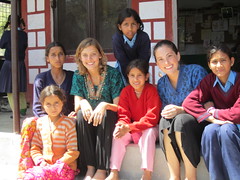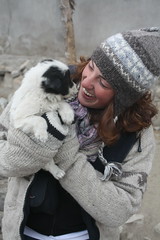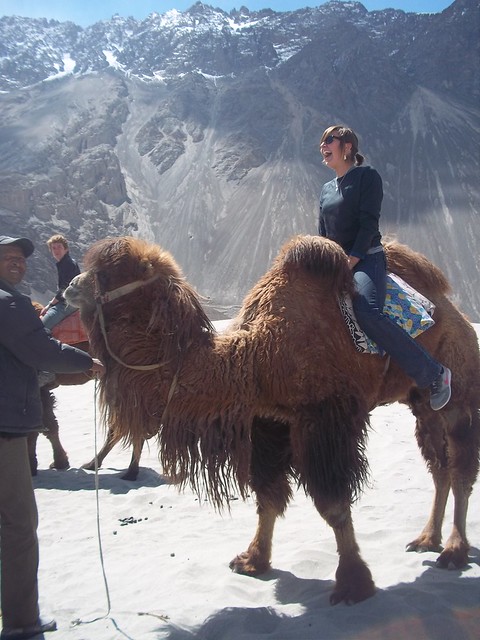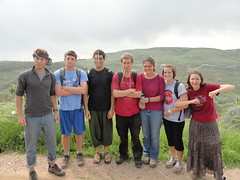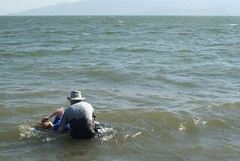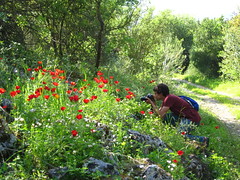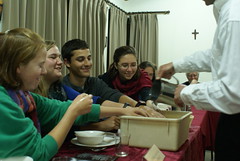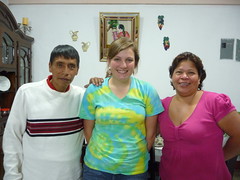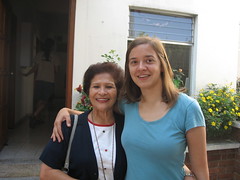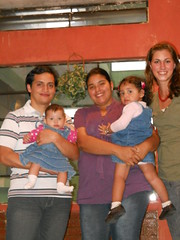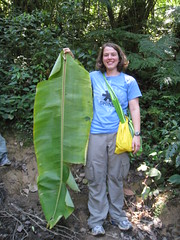 After 8 weeks of Spanish classes and living with host families here in Guatemala City, we had a week of free travel where we could go anywhere we wanted (within reason, of course). Our group of 20 students split up into smaller groups and most people headed to the beach, but my group of five people decided to do something a little bit different – we headed into the rural highlands, and we got to see a whole new side of Guatemala.
After 8 weeks of Spanish classes and living with host families here in Guatemala City, we had a week of free travel where we could go anywhere we wanted (within reason, of course). Our group of 20 students split up into smaller groups and most people headed to the beach, but my group of five people decided to do something a little bit different – we headed into the rural highlands, and we got to see a whole new side of Guatemala.
We started at an agro-ecology center, which is working to preserve the rapidly-disappearing cloud forests. We had a 3-day trek, parts of which took us through the beautiful cloud forest, and in other parts took us through what had been the cloud forest just three months ago but has since been destroyed. We spent several days in Semuc Champey, where we enjoyed the beautiful limestone pools, and ended back at the agro-ecology center, and came back to the city yesterday.
Highlights from the trip:
Our trek took us through many areas accessible only by foot, which meant that not many foreigners make it to that part of Guatemala. We were a spectacle in most of the towns that we passed. At one point we were coming up to a rural K’ekchi’ school, and as we walked closer we realized that all of the kids were coming out to watch us, and by the time we got to the school, all of the students and teachers were outside by the path. The five people in my group faced the large group of kids, and our K’ekchi’ guide told us that the kids wanted us to sing a song in English. We sang ‘Head, Shoulders, Knees, and Toes.’ They sang us a song, and then we sang ‘Father Abraham’ to them, complete with motions. They may have thought we were crazy, but we had a great time.
Our K’ekchi’ guide, Victor, became a good friend throughout the trip. He patiently taught us many K’ekchi’ phrases, which we loved practicing with the locals. The K’ekchi’ people often looked surprised when we greeted them with a K’ekchi greeting. We spent two nights with K’ekchi host families. One of these nights, two of the guys in my group played tag with some of the local kids who didn’t really know any Spanish, and it was really fun to watch them interact in a universal game of tag where it didn’t matter that we couldn’t all speak the same language. We spoke a lot of Spanish throughout the trip with other people, and more often than not Spanish was everybody’s second language, which was really cool.
In Semuc Champey, we had the opportunity to do a caving adventure one morning. Candle in hand, we entered the cave, walking through water and at times swimming, holding the candle out of the water. We climbed up and down several ladders and a waterfall, and had a great time. At one point the guide said we were 5 kilometers underground, although we were skeptical that we were that far under. It was really cool.
We had a great time, busy as it was. It was great to be out of the city and in the middle of the mountains. We helped plant some trees, played in a river, explored three different caves, trekked through the cloud forest, ate some good food, hiked through mud, conversed with some Mormons from the US, had crazy fun rides in the back of many pick-ups, spent time laying in the middle of (abandoned) roads looking at the vast expanse of stars, went swimming in beautiful natural limestone pools, and had many great views.
Next we’re heading to Chiapas, Mexico for a week and a half, where we’ll live with a coffee-farming community. Another chance to get out of the city for a while, which is okay with me, and more chances to make many more great memories!
-Melanie Sherer
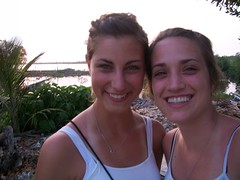 “Rise up this mornin’, smiled with the risin’ sun, three little birds perch by my doorstep singin’ sweet songs, of melodies pure and true. Sayin’, “This is my message to you-ou-ou:”
“Rise up this mornin’, smiled with the risin’ sun, three little birds perch by my doorstep singin’ sweet songs, of melodies pure and true. Sayin’, “This is my message to you-ou-ou:”
Singin’: “Don’t worry about a thing, worry about a thing, ´cause every little thing is gonna be all right.”
-Bob Marley
If I were to summarize our week of travel with a song: that would be it. Our group (Ben, Lucas, Erin, and I) went in with hardly a plan at all, just a destination and the goal of relaxation. Our plan was to get to Utila, a tropical island off the coast of Honduras, and sit on the beach for a week. The atmosphere on Utila is so relaxed, though, that we couldn’t find a hotel in our price range that would take reservations, we would just have to find what was available. Don’t worry ´bout a thing, right?
So we took a bus to Honduras, spent the night in La Ceiba, and hopped a ferry the next morning for Utila. We hadn’t exchanged money at the border, so we only had U.S. dollars and a few Lempiras (the Honduran currency) and we arrived on the island on Sunday, so the bank wasn’t open, AND we hadn’t had a real meal since Friday supper, because we left at 3:30 AM and the bus only served snacks. So we were hungry, tired, running low on water, and almost penniless. We found cheap food, though, and even had enough money for ice cream. Once again, “Every little thing, is gonna be alright”.
The rest of the week was much less stressful after we exchanged money on Monday. We spent days on the beach and nights playing card games, journaling, and watching geckos. Tuesday we woke up early and went snorkeling for the day. We saw many colorful fish and coral, and even swam with a sea turtle! Hours were spent floating on top of the water, amazed at the world below, with only a few coral casualties and sunburns.
Overall, the week was as relaxing as we had hoped it would be though there were, of course, many small adventures on the way. Just a few of our adventures or memorable moments:
An ant infestation in my bed, a giant rat in the kitchen, cockroaches, an un-flushing toilet, a leaky sink that flooded the bathroom, no hot water, grapefruit juice in bags, hundreds of bug bites, LOTS of walking, LOTS of sweat, 800 lb. gorilla, bike crashes, eating a ½ gallon of ice cream in just a few minutes, the house shaking, strange native language, “philosophical on the beach”, coconuts, sunburn, and angry iguanas.
Bob Marley´s voice followed us all week, either through songs playing on the beach, or in restaurants, or our own singing during late night card games. And through all of our adventures, Bob Marley was exactly right, there were disappointments, unexpected twists, obnoxious hotel neighbors, and lots of bugs… but every little thing was, indeed, alright.
-Jenn Leaman
 Free Travel Part 1: Rose Byler and Stephanie DeHart
Free Travel Part 1: Rose Byler and Stephanie DeHart
Friday afternoon, we left for Xela on a Pullman bus where we would began a three day trek. We learned that the ¨Minerva Terminal¨ in Xela is actually a four way intersection of buses without any type of traffic signs. With a microbus, walking, and Rose´s map skills we soon found the Quetzaltrekkers.
At 6:30 Saturday morning, we met the rest of the group for breakfast. In our group there were 6 people from the U.S., 2 from Israel, and us. Our three guides were from the Netherlands, Ireland, and California. Needless to say, there was little Spanish on this trip!
We started the hike in Xecam, a town bordering Xela. We climbed up out of the valley; it was steep, but the vistas were worth it! Our day´s hike was filled with walking in a cloud forrest, having conversations within our group and with people we passed, seeing the farming communities up close, and drinking Israeli coffee with cardamom. That night, we stayed in the municipal building of Santa Catarina, a town deeply affected by mudslides.
The second day, we experienced more beautiful views, walked along a river, and ascended many more climbs. That night, we stayed with the indigenous family of Don Juan in Xiprian. In the morning, we left at four a.m. to hike to an overlook of the Lake of Atitaln, surrounded by volcanoes. There, we watched the sun rise and enjoyed our last breakfast before hiking down to San Pedro, where our trek ended. We returned to CASAS for a night before heading on to Belize for Free Travel Part 2
-Stephanie DeHart
 Where do I even begin? We left Saturday around 5:00 a.m. Full of anxiety we left for zone 1 in two unexpected taxi cabs. We arrived to this bus station where immediately our bags where thrown in the bus and we were rushed on the bus hoping that it would take us to our destination. Thankfully we got on the right bus. Along the way were two evangelicals preaching the bible right in front of our group, people selling things on the bus, and people getting on and off every 10 minutes or so until we hit the highway. Then our first stop: Rio Dulce. In Rio Dulce we stayed at Bruno’s which has a beautiful view of the river. Not much to do there but relax in the heat of the day, maybe take a quick dip in the pool or go out into the market. When we weren’t browsing around or relaxing in our hotel, we were probably at the Sundog Café (owned by a man from Switzerland) playing card games. Just outside of town though were waterfalls and old rundown castles to bring the whole family to.
Where do I even begin? We left Saturday around 5:00 a.m. Full of anxiety we left for zone 1 in two unexpected taxi cabs. We arrived to this bus station where immediately our bags where thrown in the bus and we were rushed on the bus hoping that it would take us to our destination. Thankfully we got on the right bus. Along the way were two evangelicals preaching the bible right in front of our group, people selling things on the bus, and people getting on and off every 10 minutes or so until we hit the highway. Then our first stop: Rio Dulce. In Rio Dulce we stayed at Bruno’s which has a beautiful view of the river. Not much to do there but relax in the heat of the day, maybe take a quick dip in the pool or go out into the market. When we weren’t browsing around or relaxing in our hotel, we were probably at the Sundog Café (owned by a man from Switzerland) playing card games. Just outside of town though were waterfalls and old rundown castles to bring the whole family to.
On Monday we made our way to Livingston. It might have gotten 10 degrees hotter when we arrived, or at least it felt like it. There in Livingston the main tourist attractions were on this one long road. But that wasn’t good enough for my group. We got a tour from a very interesting old man to get to know the “real” Livingston. Wow, outside of this long road is this whole separate land where the Garifunua people live. Racism is very prevalent over there, but because of that they have a huge sense of community.
Belize on Wednesday! This is where we spent most of our time. We met up with another group for Kiersten Rossetto’s 20th birthday party! Other than that, 7 of us (2 newly aquired members) stayed at Lydia’s Guest house that was about a minute walk from the beach. Here the girls visited the beach while I wondered around Belize for a little bit. We just relaxed until Friday when we went snorkeling. That was my first time ever. We saw a lot of sea life, shells, coral, and much more. We just missed the dolphins though. Though it was still amazing. Saturday we left for Punta Gorda to stay the night so we would have a shorter trip back to Guatemala City.
This trip was filled with laughter, riding in the back of pick-up trucks, sunburn (except for me, of course), card games, boat rides, and most importantly getting to know each other as well as getting to know new faces. This trip I will certainly never forget.
-Cody Walker
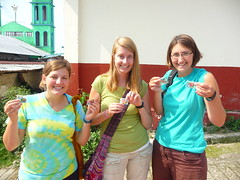 A break from the city, time to relax in a tranquil little town, and all the coffee we ever wanted to drink. What a wonderful ten days our group spent in the coffee growing community of Salvador Urbina, Chiapas, Mexico. While we spent a lot of time embracing local culture: sitting around, talking, and watching the world go by, and playing soccer, we also spent a lot of time learning.
A break from the city, time to relax in a tranquil little town, and all the coffee we ever wanted to drink. What a wonderful ten days our group spent in the coffee growing community of Salvador Urbina, Chiapas, Mexico. While we spent a lot of time embracing local culture: sitting around, talking, and watching the world go by, and playing soccer, we also spent a lot of time learning.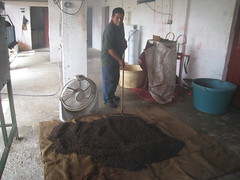 During the day, we often had lots of free time, but we also had some activities scheduled to learn more about the community. On Wednesday, our first full day there, we went with two of the cooperative members to their coffee parcels to see what a real shade grown coffee farm looks like. They explained about the many types of trees and everything about how they care for the plants. All the trees were grown on steep hills and kept at a height where coffee pickers could reach them. All of the harvest must be done by hand because every coffee tree is different and the terrain is not ideal for automating coffee harvesting. The next day, we had a tour of the warehouse and all the machinery used to process the coffee before it is sent to the cooperative’s roaster in Agua Prieta, near the border of Arizona and Mexico. We also attended a weekly meeting of the cooperative that evening.
During the day, we often had lots of free time, but we also had some activities scheduled to learn more about the community. On Wednesday, our first full day there, we went with two of the cooperative members to their coffee parcels to see what a real shade grown coffee farm looks like. They explained about the many types of trees and everything about how they care for the plants. All the trees were grown on steep hills and kept at a height where coffee pickers could reach them. All of the harvest must be done by hand because every coffee tree is different and the terrain is not ideal for automating coffee harvesting. The next day, we had a tour of the warehouse and all the machinery used to process the coffee before it is sent to the cooperative’s roaster in Agua Prieta, near the border of Arizona and Mexico. We also attended a weekly meeting of the cooperative that evening. cooperative. On Tuesday, our group took a truck ride to El Aguila to see a beautiful waterfall and swim at the base of it. Then we went to see Adan Mendes, a member of the cooperative who lives in El Aguila and also runs a water purification system out of his house for the community of El Aguila. Wednesday, we visited the school and got to see many of our host siblings in their classes. Thursday, we visited the clinic and then the library.
cooperative. On Tuesday, our group took a truck ride to El Aguila to see a beautiful waterfall and swim at the base of it. Then we went to see Adan Mendes, a member of the cooperative who lives in El Aguila and also runs a water purification system out of his house for the community of El Aguila. Wednesday, we visited the school and got to see many of our host siblings in their classes. Thursday, we visited the clinic and then the library.